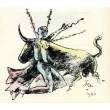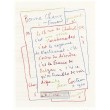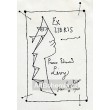Košík
0
x
Produkty
(prázdný)
Žádné díla
Bude determinováno
Dopravné a balné
0 Kč
Celkem
Produkt byl úspěšně přidán do nákupního košíku
Počet
Celkem
0 ks zboží.
1 dílo v košíku.
Za díla:
Doručení a balné:
Bude determinováno
Celkem
Kategorie
- grafiky/tisky
- obrazy
- kresby
- plakáty
- fotografie
- exlibris
- bibliofilie
- knihy/katalogy
- starožitnosti
- sochy/plastiky
- sklo
-
Hnutí
- abstrakce
- art-deco
- čs.avantgarda/moderna
- expresionismus
- fauvismus
- impresionismus
- kubismus
- naivní umění
- op-art
- poetismus
- pop-art
- realismus
- secese
- sociální kritika
- soudobá tvorba
- surrealismus
- světová avantgarda/moderna
- Škola prof. Albína Brunovského
- Škola prof. Zdeňka Sklenáře
- Škola prof.Julia Mařáka - mařákovci
- Žánr
- Zprávy/NEWS
- Doporučujeme
-

La Danseuse Créole
15 972 Kč -40% 26 620 Kč
Hnutí
- abstrakce
- art-deco
- čs.avantgarda/moderna
- expresionismus
- fauvismus
- impresionismus
- kubismus
- naivní umění
- op-art
- poetismus
- pop-art
- realismus
- secese
- sociální kritika
- soudobá tvorba
- surrealismus
- světová avantgarda/moderna
- Škola prof. Albína Brunovského
- Škola prof. Zdeňka Sklenáře
- Škola prof.Julia Mařáka - mařákovci
Žánr
NEJŽÁDANĚJŠÍ UMĚLCI
- Anderle Jiří
- Augustovič Peter
- Benca Igor
- Beneš Karel
- Bím Tomáš
- Born Adolf
- Brun Robert
- Brunovský Albín
- Boštík Václav
- Bouda Cyril
- Bouda Jiří
- Braque Georges
- Brázda Jiří
- Buffet Bernard
- Cézanne Paul
- Čapek Josef
- Čápová Hana
- Dalí Salvador
- Demel Karel
- Dudek Josef
- Dufy Raoul
- Effel Jean
- Felix Karol
- Filla Emil
- Giacometti Alberto
- Grosz George
- Chagall Marc
- Istler Josef
- Janeček Ota
- Jiřincová Ludmila
- Kandinsky Wassily
- Kĺúčik Peter
- Komárek Vladimír
- Kulhánek Oldřich
- Kupka František
- Lada Josef
- Lhoták Kamil
- Matisse Henri
- Miró Joan
- Mucha Alfons
- Muzika František
- Picasso Pablo
- Pileček Jindřich
- Reynek Bohuslav
- Sukdolák Pavel
- Suchánek Vladimír
- Svolinský Karel
- Šíma Josef
- Špála Václav
- Švabinský Max
- Švengsbír Jiří
- Tichý František
- Toulouse-Lautrec Henri de
- Toyen
- Trnka Jiří
- Váchal Josef
- Vik Karel
- Warhol Andy
- Zábranský Vlastimil
- Zoubek Olbram
- Zrzavý Jan
Seznam děl umělce Cocteau Jean
Jean Cocteau was born at Maison Lafitte in 1889. Issued from a Parisian upper middle class family, Cocteau studied at the Condorcet College in Paris. he is nine years old when his father commits suicide. Cocteau is sent down from Condorcet college in 190
Jean Cocteau was born at Maison Lafitte in 1889. Issued from a Parisian upper middle class family, Cocteau studied at the Condorcet College in Paris. he is nine years old when his father commits suicide. Cocteau is sent down from Condorcet college in 1904 for indiscipline. At 19 years he meet the famous tragic actor Edouard de Max. This last is subjugated by the writing of Cocteau and organizes in its honor one morning poetic where the poems of the young author are read. The following year Cocteau meet Marcel Proust and the contess of Noailles and he publish his first collection of poems, "La lampe d'Aladin" (the lamp of Aladdin). In 1912, Cocteau meet Stravinsky and Diaghilev, "Le sacre du printemps" created the following year will not be a success for the public. During the year 1914, Cocteau is an ambulance man in champagne ; the following year, he meets Satie, Picasso, Braque and Derain and takes part in various artistic events at their sides, among which the first of the realistic ballet "Parades" with Diaghilev, music of Eric Satie, decorations of Picasso. Cocteau publishes the poems of the "Cap de bonne espérance", "Ode à Picasso", "Le coq et l'arlequin", "Le Potomak" in 1919 and makes the knowledge of Raymond Radiguet with whom he creates "Le gendarme incompris" and create the review "Le coq" in 1920. Cocteau published numerous works at the beginning of the Twenties, "Thomas l'imposteur", "Le grand écart", "L'Ange Heurtebise ". December 20, 1923, Radiguet died suddenly, Cocteau is very affected and declare that he don't want to write anymore. By despair, the artist starts to devote himself to opium and in spite of cures of detoxication, it will consume drugs until the end of his life. In 1928, Cocteau published "Le livre blanc" (the White book), without any name of author and of editor. The first representation of "Orphée" takes place in 1926 and the following year the first of "Oedipus Rex". In 1929, Cocteau published the famous "Les enfants terribles", he is hospitalized the following year for 40 days because of typhoid. The artist meets Jean Marais in 1939. Cacteau is often fined by the jsutice for use of narcotics. The Forties are the years of success for Jean Cocteau (first of the "Monstres sacrés", movie "La belle et la bête" and especially triumph of "Antigone" to the Opera of Paris and of film "L'éternel retour"). In 1953, Cocteau is a president of the Jury of the Festival of Cannes. Following year, it is victim of a myocardial infarction. At side of the theatre, cinema and writing, we can add to the pallet of the talents of Cocteau that of draughtsman and painter. The artist thus illustrated several works of prints, he also decorated the Vaults at Villefranche and Milly la Forêt. He also produced many lithographs and engravings, as well as drawings. Jean Cocteau is elected at the French Academy on March 3, 1955 ; receipt by Andre Maurois, Cocteau describes the Cupola like "some underwater cave, a quasi supernatural light of aquarium and on steps in half-circle, forty sirens with green tails and mélodieuses voices". After a new cardiac attack, Cocteau writes "Requiem" in 1955, his poetic will. In 1960, the artist turns "Le testament d'Orphée" with the financial assistance of François Truffaut. Jean Cocteau died on October 11, 1963 In: http://www.michelfillion.com/oeuvres_eng.php?artiste=COCTEAU
Cocteau, Jean (1889-1963), French poet, novelist, dramatist, designer, librettist and film director, whose versatility, unconventionality, and enormous output brought him international acclaim. He was a leading member of the surrealist movement, and had great influence on the work of others.
Cocteau was born on July 5, 1889, at Maisons-Laffitte, near Paris. Overindulged by his mother (his father committed suicide in 1898), he was a poor student, and his lack of motivation overshadowed his intellect. He dropped out of school and left Paris. At the age of 16, Cocteau met the actor Édouard de Max, who launched him as a poet. At de Max's invitation, a fashionable audience attended a reading of Cocteau's poems on April 4, 1908. His first volume of verse, La Lampe d'Aladin, appeared in 1909 and quickly established him as an important writer.
The establishment of the Ballets Russes in Paris in 1909 brought its great impresario Sergei Diaghilev into Cocteau's world and involved the poet in the theatre. After Cocteau expressed his wish to create ballets, Diaghilev challenged him to “Surprise me”. Diaghilev later produced Cocteau's ballet scenarios: Parade (1917, music by the French composer Erik Satie) and Le Boeuf sur le toit (The Nothing-Doing Bar, 1920, music by the French composer Darius Milhaud).
During World War I Cocteau served in the Red Cross as an ambulance driver. During that same period he met Guillaume Apollinaire, Pablo Picasso, Amedeo Modigliani, and many other writers and artists with whom he later collaborated or who influenced his life. In 1923 Cocteau became addicted to opium, an experience described in Opium (1923), and was forced to spend a period of recovery in a sanatorium. During this time he produced some of his major works—the plays Orphée (1926; Orpheus, 1933) and La Machine infernale (1934; The Infernal Machine, 1936); the novel Children of the Game (1929; trans. 1955); and his first film, Le Sang d'un počte (Blood of a Poet, 1930).
Cocteau's films, most of which he both wrote and directed, were especially important in introducing surrealism into the French cinema. Several of them—particularly La Belle et la bęte (Beauty and the Beast, 1945), Orphée (Orpheus, 1950), and Les Enfants terribles (1950)—have come to be regarded as modern film classics.
Despite his achievements in virtually all literary and artistic fields, Cocteau insisted that he was primarily a poet and that all his work was poetry. He died at Milly-la-Fôret, near Fontainebleau, on October 11, 1963.
In: MS Encarta
Zobrazit
Cocteau, Jean (1889-1963), French poet, novelist, dramatist, designer, librettist and film director, whose versatility, unconventionality, and enormous output brought him international acclaim. He was a leading member of the surrealist movement, and had great influence on the work of others.
Cocteau was born on July 5, 1889, at Maisons-Laffitte, near Paris. Overindulged by his mother (his father committed suicide in 1898), he was a poor student, and his lack of motivation overshadowed his intellect. He dropped out of school and left Paris. At the age of 16, Cocteau met the actor Édouard de Max, who launched him as a poet. At de Max's invitation, a fashionable audience attended a reading of Cocteau's poems on April 4, 1908. His first volume of verse, La Lampe d'Aladin, appeared in 1909 and quickly established him as an important writer.
The establishment of the Ballets Russes in Paris in 1909 brought its great impresario Sergei Diaghilev into Cocteau's world and involved the poet in the theatre. After Cocteau expressed his wish to create ballets, Diaghilev challenged him to “Surprise me”. Diaghilev later produced Cocteau's ballet scenarios: Parade (1917, music by the French composer Erik Satie) and Le Boeuf sur le toit (The Nothing-Doing Bar, 1920, music by the French composer Darius Milhaud).
During World War I Cocteau served in the Red Cross as an ambulance driver. During that same period he met Guillaume Apollinaire, Pablo Picasso, Amedeo Modigliani, and many other writers and artists with whom he later collaborated or who influenced his life. In 1923 Cocteau became addicted to opium, an experience described in Opium (1923), and was forced to spend a period of recovery in a sanatorium. During this time he produced some of his major works—the plays Orphée (1926; Orpheus, 1933) and La Machine infernale (1934; The Infernal Machine, 1936); the novel Children of the Game (1929; trans. 1955); and his first film, Le Sang d'un počte (Blood of a Poet, 1930).
Cocteau's films, most of which he both wrote and directed, were especially important in introducing surrealism into the French cinema. Several of them—particularly La Belle et la bęte (Beauty and the Beast, 1945), Orphée (Orpheus, 1950), and Les Enfants terribles (1950)—have come to be regarded as modern film classics.
Despite his achievements in virtually all literary and artistic fields, Cocteau insisted that he was primarily a poet and that all his work was poetry. He died at Milly-la-Fôret, near Fontainebleau, on October 11, 1963.
In: MS Encarta
Fotografie
 |  |  |
Zobrazeno 1 – 3 z 3 položek
Zobrazeno 1 – 3 z 3 položek






